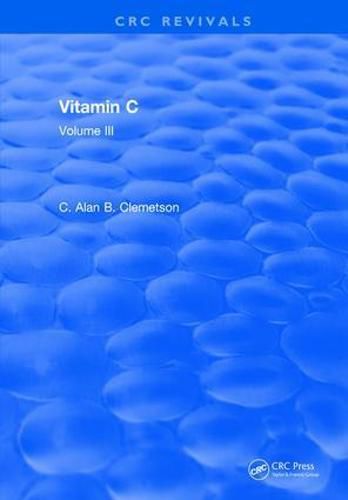Readings Newsletter
Become a Readings Member to make your shopping experience even easier.
Sign in or sign up for free!
You’re not far away from qualifying for FREE standard shipping within Australia
You’ve qualified for FREE standard shipping within Australia
The cart is loading…






The factors affecting blood vitamin C levels are described in detail in this series. Many factors such as aging, smoking, infection, trauma, surgery, hemolysis, hormone administration, heavy metals, pregnancy, alcohol, ionizing radiation and several medicines have been found to cause a disturbance of ascorbic acid metabolism and to reduce blood vitamin C levels. Indeed, abnormalities of ascorbic acid metabolism, due to factors such as smoking, occur much more frequently than does dietary vitamin C deficiency today.It is now known that low blood vitamin C levels are associated with histaminemia (high blood histamine levels), and also that ascorbate-responsive histaminemia is common in apparently healthy people. High blood histamine levels are believed to cause small hemorrhages within the inner walls of the blood vessels and these may lead to the deposition of cholesterol, as an aberrant form of wound healing. Ascorbic acid not only reduces blood histamine levels, but also aids the conversion of cholesterol to bile acids in the liver. The clinical pathological and chemical changes observed in ascorbic acid deficiency are discussed in detail. Several diseases and disorders associated with low blood vitamin C levels are also described. Possible toxic effects resulting from the oxidation of ascorbic acid are noted, and reasons for the use of D-catechin or other chelating fiber to prevent or minimize the release of ascorbate-free radical are detailed. An excellent reference for physicians, nutritionists and other scientists
$9.00 standard shipping within Australia
FREE standard shipping within Australia for orders over $100.00
Express & International shipping calculated at checkout
The factors affecting blood vitamin C levels are described in detail in this series. Many factors such as aging, smoking, infection, trauma, surgery, hemolysis, hormone administration, heavy metals, pregnancy, alcohol, ionizing radiation and several medicines have been found to cause a disturbance of ascorbic acid metabolism and to reduce blood vitamin C levels. Indeed, abnormalities of ascorbic acid metabolism, due to factors such as smoking, occur much more frequently than does dietary vitamin C deficiency today.It is now known that low blood vitamin C levels are associated with histaminemia (high blood histamine levels), and also that ascorbate-responsive histaminemia is common in apparently healthy people. High blood histamine levels are believed to cause small hemorrhages within the inner walls of the blood vessels and these may lead to the deposition of cholesterol, as an aberrant form of wound healing. Ascorbic acid not only reduces blood histamine levels, but also aids the conversion of cholesterol to bile acids in the liver. The clinical pathological and chemical changes observed in ascorbic acid deficiency are discussed in detail. Several diseases and disorders associated with low blood vitamin C levels are also described. Possible toxic effects resulting from the oxidation of ascorbic acid are noted, and reasons for the use of D-catechin or other chelating fiber to prevent or minimize the release of ascorbate-free radical are detailed. An excellent reference for physicians, nutritionists and other scientists